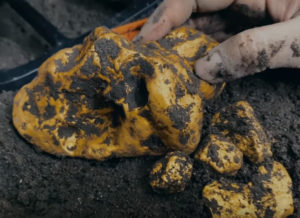Finding a large gold nugget patch – Metal Detecting Gold Nuggets
Some facts about us and the island: Based on local folklore, the island is pretty much just a big active volcano that last erupted some 470 years ago. This is a fact and verified based on historical records.
Metal Detecting Gold Nuggets

large gold nuggets
But what remains a folklore is the story that the volcano slew some molten gold on its main outlet, together with what they called, the hardglass, which is believed to be diamonds by the prospectors. This same story is known throughout the island and possibly the whole country. but very few believe this, and the government seems to be hiding this to harvest the gold ores after they get rid of the rebels.
From Wikipedia, the free encyclopedia:
Two gold nuggets are claimed as the largest in the world: the Welcome Stranger and the Canaã nugget, the latter being the largest surviving natural nugget. Considered by most authorities to be the biggest gold nugget ever found, the Welcome Stranger was found at Moliagul, Victoria, Australia in 1869 by John Deason and Richard Oates. It weighed gross, over 2,520 troy ounces (78 kg; 173 lb) and returned over 2,284 troy ounces (71.0 kg; 156.6 lb) net. The Welcome Stranger is sometimes confused with the similarly named Welcome Nugget, which was found in June 1858 at Bakery Hill, Ballarat, Australia by the Red Hill Mining Company. The Welcome weighed 2,218 troy ounces (69.0 kg; 152.1 lb). It was melted down in London in November 1859.
The Canaã nugget, also known as the Pepita Canaa, was found on September 13, 1983 by miners at the Serra Pelada Mine in the State of Para, Brazil. Weighing 1,955 troy ounces (60.8 kg; 134.1 lb) gross, and containing 1,682.5 troy ounces (52.33 kg; 115.37 lb) of gold, it is among the largest gold nuggets ever found, and is, today, the largest in existence. The main controversy regarding this nugget is that the excavation reports suggest that the existing nugget was originally part of a nugget weighing 5,291.09 troy ounces (165 kg; 363 lb) that broke during excavations. The Canaã nugget is displayed at the Banco Central Museum in Brazil along with the second and third largest nuggets remaining in existence, weighing respectively 1,506.2 troy ounces (46.85 kg; 103.28 lb) and 1,393.3 troy ounces (43.34 kg; 95.54 lb), which were also found at the Serra Pelada region.
The largest gold nugget found using a metal detector is the Hand of Faith, weighing 875 troy ounces (27.2 kg; 60.0 lb), found in Kingower, Victoria, Australia in 1980.
Historic large specimens include the crystalline “Fricot Nugget”, weighing 201 troy ounces (6.3 kg; 13.8 lb) – the largest one found during the California Gold Rush. It is on display at the California State Mining and Mineral Museum.
The largest gold nugget ever found in weighed 1,593 troy ounces (49.5 kg; 109.2 lb). It was found in August 1869 in Sierra Buttes by five partners – W.A. Farish, A. Wood, J. Winstead, F.N.L. Clevering and Harry Warner.
+++++++
Visit our Youtube Gold Prospecting channel & Subscribe
See our gold nuggets for sale
+++++++++++++++++++++++++++++++++
0 Comments